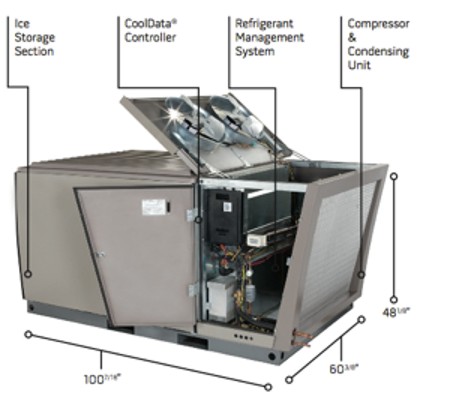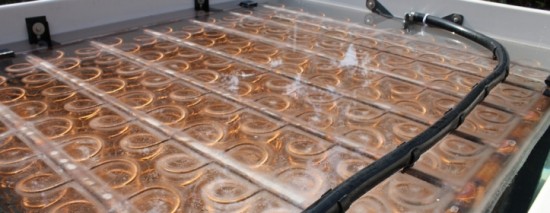May 5, 2016 – It’s called the Ice Bear and since 2005 it has been installed in more than 40 locations where it has transformed the way buildings are air conditioned. How does it differ from conventional air conditioning (AC) units. It uses electricity during off-peak periods to make ice. And during peak heat of the day periods it uses the ice to cool reducing electricity demand by 95% for up to 6 hours every day. It doesn’t replace conventional AC but is an adjunct to it. There are two models: Ice Bear 30 for commercial buildings, and Ice Bear 20 for home use. So instead of running energy demanding compressors to cool a building or home, Ice Bears use stored ice and the AC fan whether in a standalone unit or integrated with a home heating and AC vented system.
Each Ice Bear system (see diagram above) contains performance monitoring sensors that measure:
- Coolant systems pressure
- Ice Temperature
- Control housing temperature
- Outside ambient temperature
- Ice Bear components
- Supply and return air temperature, on either side of the air handler
- Indoor thermostat
- AC compressor on/off status
If you look under the hood the most striking feature that makes Ice Bear systems different from conventional AC are the copper cooling coils which can be seen in the image below, a pilot project recently installed near the polar bear exhibit (which seems apt) at the Toronto Zoo.
The unit is remotely controlled allowing operators to direct it to make or melt ice, to alter its daily charge and discharge schedule, and to establish its cooling rate. Operators can continuously monitor battery performance on a dashboard display which can handle multiple storage units through a wireless network.
How does Ice Bear differ from Tesla’s PowerWall? The latter uses lithium-ion chemical batteries that have a limited charging and discharging life cycles. Ice Bear dispenses with catalysts and oxidizers entirely. This overcomes the battery lifecycle problem. A typical Ice Bear unit can last 20 years or more. There is no battery storage technology in commercial existence today that can match that type of longevity.
And Ice Bears cost far less than conventional battery storage. The company, Ice Energy, which is located in Santa Barbara, California and manufactures its units in Hammondsport, New York, states that an Ice Bear unit will cost less than half of a comparably rated lithium-ion powered storage system. It describes its technology as complimentary to renewable solar because during peak sun when the panels are over-charging the Ice Bear can make unlimited amounts of ice needed for AC. That means an AC system can obtain optimal cooling without the need to run energy-intensive compressors. For utility operators the net impact to the grid is a reduction in firing up peaker plants during high demand. The fewer of these plants operating, almost all coal or natural-gas fired, means lower carbon emissions.
So how much? An Ice Bear 20, designed for individual home owners, costs no more than a conventional AC system to purchase and install. But the downstream savings mean home operators will save more than 40% on annual cooling costs.
Both Ice Bear models are available now. The model 20 was launched this past February and home owners can contact the company to find local certified AC installers.


















[…] Ice Bear uses unique cooling system to produce ice in off-peak energy periods and then melts it to cool homes and buildings. […]